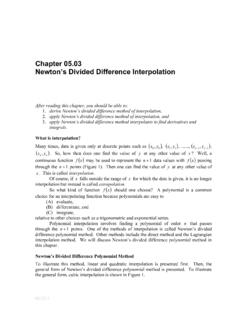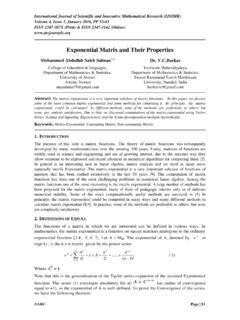Transcription of Lagrange & Newton interpolation
1 Lagrange & Newton interpolationIn this section, we shall study the polynomial interpolation in the form of Lagrange and Newton . Given a se-quence of (n +1) data points and a function f, the aim is to determine an n-th degree polynomial which interpol-ates f at these points. We shall resort to the notion of divided (n+1) points {(x0, y0), (x1, y1), .., (xn, yn)}, the points defined by (xi)0 i n are called points of interpolation . The points defined by (yi)0 i n are the values of interpolation . To interpolate a function f, the values of interpolation are defined as follows:yi = f(xi), i = 0, .., interpolation polynomialThe purpose here is to determine the unique polynomial of degree n, Pn which verifies Pn(xi) = f(xi), i = 0.
2 , polynomial which meets this equality is Lagrange interpolation polynomial Pn x = j=0nlj x f xj where the lj s are polynomials of degree n forming a basis of Pnlj x = i=0,i jnx xixj xi=x x0xj x0 x xj 1xj xj 1x xj 1xj xj 1 x xnxj xnProperties of Lagrange interpolation polynomial and Lagrange basisThey are the lj polynomials which verify the following property: lj xi = ji={1i=j0i j, i=0,.., form a basis of the vector space Pn of polynomials of degree at most equal to n j=0n jlj x =0By setting: x = xi, we obtain: j=0n jlj xi = j=0n j ji=0 i=0 The set (lj)0 j n is linearly independent and consists of n + 1 vectors. It is thus a basis of Pn. Finally, we can easily see that: Pn xi = j=0nlj xi f xi = j=0n jif xi =f xi Example: computing Lagrange interpolation polynomialsGiven a set of three data points {(0, 1), (2, 5), (4, 17)}, we shall determine the Lagrange interpolation polynomial of degree 2 which passes through these , we compute l0, l1 and l2: l0 x = x 2 x 4 8,l1 x = x x 4 4,l2 x =x x 2 8 Lagrange interpolation polynomial is: Pn = l0(x) + 5l1(x) + 17l2(x) = 1 + x2 Scilab: computing Lagrange interpolation polynomialThe Scilab function determines Lagrange interpolation polynomial.}
3 X encompasses the points of interpolation and Y the values of interpolation . P is the Lagrange interpolation [P]= Lagrange (X,Y) //X nodes,Y values;P is the numerical Lagrange polynomial interpolationn=length(X); // n is the number of nodes. (n-1) is the degreex=poly(0,"x");P=0;for i=1:n, L=1; for j=[1:i-1,i+1:n] L=L*(x-X(j))/(X(i)-X(j));end P=P+L*Y(i); endendfunction-->X=[0;2;4]; Y=[1;5;17]; P= Lagrange (X,Y) P = 1 + x^2 Such polynomials are not convenient, since numerically, it is difficult to deduce lj+1 from lj. For this reason, we introduce Newton s interpolation polynomial. Newton s interpolation polynomial and Newton s basis propertiesThe polynomials of Newton s basis, ej, are defined by: ej x = i=0j 1 x xi = x x0 x x1 x xj 1 ,j=1.
4 , the following convention: e0=1 Moreover e1 = (x x0)e2 = (x x0)(x x1)e3 = (x x0)(x x1)(x x2) en = (x x0)(x x1) (x xn-1)The set of polynomials (ej)0 j n ( Newton s basis) are a basis of Pn, the space of polynomials of degree at most equal to n. Indeed, they constitute an echelon-degree set of (n + 1) polynomials. Newton s interpolation polynomial of degree n related to the subdivision {(x0, y0), (x1, y1), .., (xn, yn)} is: Pn x = j=0n jej x = 0 1 x x0 2 x x0 x x1 n x x0 x x1 x xn 1 where Pn(xi) = f(xi), i = 0, .., shall see how to determine the coefficients ( j)0 j n in the following section entitled the divided differences.
5 divided differencesNewton s interpolation polynomial of degree n, Pn(x), evaluated at x0, gives: Pn x0 = j=0n jej x0 = 0=f x0 =f[x0]Generally speaking, we write: f[xi] = f(xi), i = 0, .., nf[x0] is called a zero-order divided difference. Newton s interpolation polynomial of degree n, Pn(x), evaluated at x1, gives: Pn x1 = j=0n jej x1 = 0 1 x1 x0 =f[x0] 1 x1 x0 =f[x1]Hence 1=f[x1] f[x0]x1 x0=f[x0,x1]f[x1,x0] is called 1st -order divided difference. Newton s interpolation polynomial of degree n, Pn(x), evaluated at x2, gives: Pn x2 = j=0n jej x2 = 0 1 x2 x0 2 x2 x0 x2 x1 =f[x0] f[x0,x1] x2 x0 2 x2 x0 x2 x1 =f[x2]Therefore: 2 x2 x0 x2 x1 =f[x2] f[x0] f[x0,x1] x2 x0 2=f[x2] f[x0] f[x0,x1] x2 x0 x2 x0 x2 x1 2=f[x2] f[x0] x2 x0 x2 x1 f[x0,x1]x2 x1 2=f[x0,x2] f[x0,x1]x2 x1 The following form is generally preferred.
6 2 x2 x0 x2 x1 =f[x2] f[x0] f[x0,x1] x2 x0 2 x2 x0 x2 x1 =f[x2] f[x0] f[x0,x1] x2 x0 f[x1] f[x1] 2 x2 x0 x2 x1 =f[x2] f[x1] f[x1] f[x0] f[x0,x1] x2 x0 2 x2 x0 x2 x1 =f[x2] f[x1] x1 x0 f[x0,x1] f[x0,x1] x2 x0 2 x2 x0 x2 x1 =f[x2] f[x1] x1 x2 f[x0,x1] 2 x2 x0 =f[x2] f[x1]x2 x1 f[x0,x1] 2 x2 x0 =f[x1,x2] f[x0,x1]Hence 2=f[x1,x2] f[x0,x1]x2 x0=f[x0,x1,x2]f[x0, x1, x2] is called 2nd-order divided difference. By recurrence, we obtain: k=f[x1, ,xk] f[x0, ,xk 1]xk x0=f[x0, ,xk]f[x0, .., xk] is thus called a kth-order divided difference. In practice, when we want to determine the 3rd-order divided difference f[x0, x1, x2, x3] for instance, we need the following quantities x0f[x0]x1f[x1]f[x0,x1]x2f[x2]f[x1,x2]f[x 0,x1,x2]x3f[x3]f[x2,x3]f[x1,x2,x3]f[x0,x 1,x2,x3]Hence f[x0,x1,x2,x3]=f[x1,x2,x3] f[x0,x1,x2]x3 x0 Properties.
7 Let E = {0, 1, .., n} and be a permutation of G(E). Then f[x (0), .., x (n)] = f[x0, .., xn] Newton s interpolation polynomial of degree nNewton s interpolation polynomial of degree n is obtained via the successive divided differences: Pn x =f[x0] j=1nf[x0,..,xj]ej x An example of computing Newton s interpolation polynomialGiven a set of 3 data points {(0, 1), (2, 5), (4, 17)}, we shall determine Newton s interpolation polyno-mial of degree 2 which passes through these points. x0=0f[x0]=1x1=2f[x1]=5f[x0,x1]=5 12 0=2x2=4f[x2]=17f[x1,x2]=17 54 2=6f[x0,x1,x2]=6 24 0=1 Consequently: P2(x) = f[x0] + f[x0, x1]x + f[x0, x1, x2]x(x 2) = 1 + 2x + x(x 2) = 1 + x2 Scilab: computing Newton s interpolation polynomialScilab function determines Newton s interpolation polynomial.
8 X contains the points of interpolation and Y the values of interpolation . P is Newton s interpolation polynomial computed by means of divided [P]= Newton (X,Y) //X nodes,Y values;P is the numerical Newton polynomialn=length(X); // n is the number of nodes. (n-1) is the degreefor j=2:n, for i=1:n-j+1,Y(i,j)=(Y(i+1,j-1)-Y(i,j-1))/( X(i+j-1)-X(i));end,end,x=poly(0,"x");P=Y (1,n);for i=2:n, P=P*(x-X(i))+Y(i,n-i+1); endendfunction;Therefore, we obtain:-->X=[0;2;4]; Y=[1;5;17]; P= Newton (X,Y) P = 1 + x^2

